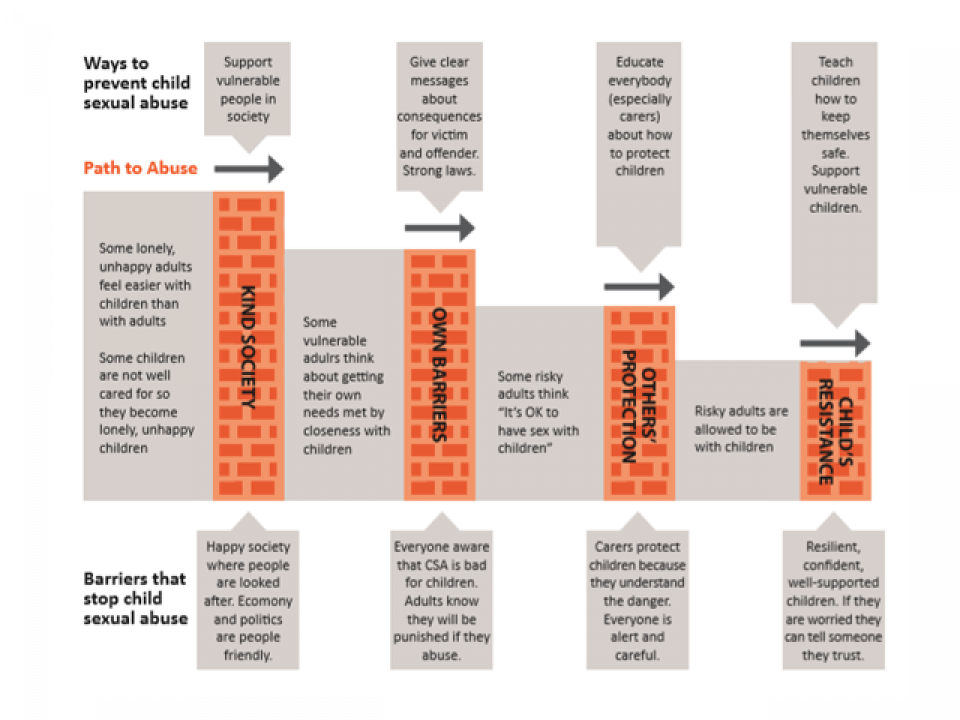Steps towards prevention
Steps towards prevention
 The journey of the offender towards sexual abuse of a child starts with the development of an interest to engage in sexual contact with a child. Factors that influence this motivation include sexual arousal to children, emotional congruence with children and a blockage to adult relationships. The backgrounds of offenders often include childhood adversity – including experiencing child sexual abuse as a victim; but also the absence or inadequacy of their parents or carer, perhaps due to drugs, alcohol misuse or domestic violence. This childhood adversity helps us understand, a little, how some people go on to abuse in later life.
The journey of the offender towards sexual abuse of a child starts with the development of an interest to engage in sexual contact with a child. Factors that influence this motivation include sexual arousal to children, emotional congruence with children and a blockage to adult relationships. The backgrounds of offenders often include childhood adversity – including experiencing child sexual abuse as a victim; but also the absence or inadequacy of their parents or carer, perhaps due to drugs, alcohol misuse or domestic violence. This childhood adversity helps us understand, a little, how some people go on to abuse in later life.
For those who go on to abuse, most will struggle with their conscience to allow themselves to progress to abuse – making excuses for their behaviour and its consequences; perhaps taking drugs or using alcohol to overcome their fear or their conscience; or blaming the abuse on the actions or wishes of the child.
The abuser usually recognises that other adults who normally protect the child would disapprove of the abuse if they saw it happening and would stop it or report it to the authorities. These other adults are obstacles to abuse that need to be overcome. We might use the word “grooming” to describe how abusers trick or mislead people around the child so that they do not see the abuse or do not intervene to stop it. This can involve a range of steps, including being seen as a “good person” who wouldn’t harm children; making excuses for strange behaviour; making people think the child lies or makes up stories. Sometimes it involves threats or violence to the other adult so they do not interfere. Of course, it is difficult for us to see people we love and care about as possible child abusers, which makes it easier for the abuser to get away with their abuse.

Figure 1 presents a model developed by Dr David Finkelhor to describe how abuse happens.
Finally, the abuser needs to overcome the resistance of his/her victim. This also often involves grooming – tricking or forcing the child in some way. Physical force is used by some offenders. But most make use of the child’s innocence, ignorance and additional vulnerabilities - for example being bullied at school, feeling lonely, lacking confidence, sexually naïve, learning disabled). We know that the vast majority of victims do not report their abuse to the Police or even parents – in part because of the grooming by the offender, who might have threatened them or told them no-one would believe them. But also because children are often not taught about sex and relationships, so are not clear about boundaries and when to report concerns to a trusted adult.
Using this understanding, we can start thinking about the kinds of things that might prevent abuse. If we help children develop confidence in themselves and in the protective adults and friends around them, the less vulnerable they become. If parents and carers understand the risks of abuse, the warning signs and the ways they can prevent abuse, the more protected children will be. If we pay good attention to children whose parents are absent or who struggle with domestic violence or alcohol and drug dependency, we can help male children in particular not develop sexually aggressive attitudes or habits. And if we are clear about the law, about the harm done to victims and the punishment for abuse, we increase the likelihood that people who might otherwise abuse simply manage their behaviour so that children are safe.

Figure 2, shows some of the ways we can start to think about preventing abuse. It also starts us thinking about what kind of society we want our children to grow up in. It looks complex, but it is worth spending time looking at each item in turn.


